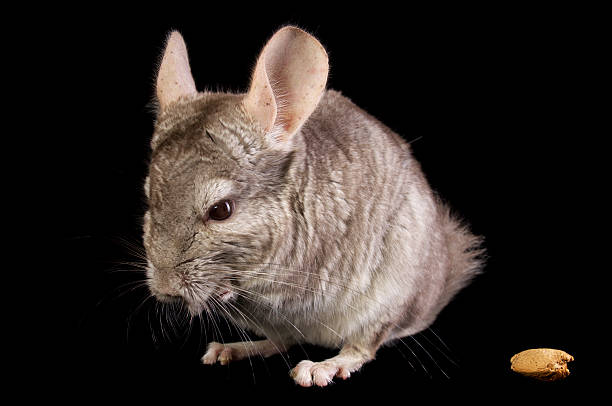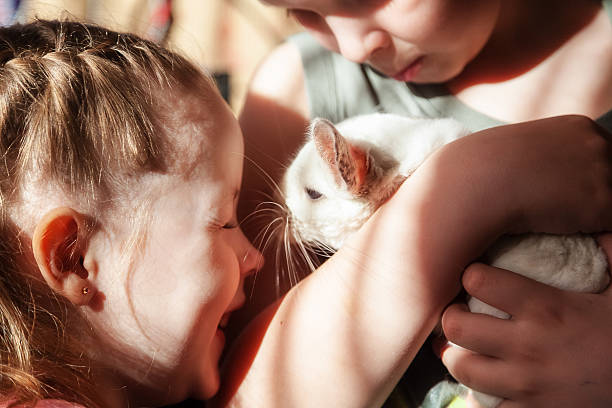Chinchilla Colours and Coats: Find the Perfect Chinchilla for You
This post contains affiliate links. This means I will make a commission at no extra cost to you should you click through and make a purchase. Read the full disclosure here.
Chinchillas are known for their endearing personalities and luxurious fur, making them one of the most sought-after small pets. Beyond their charming demeanour, chinchillas come in a stunning array of colours and coat types, adding an extra layer of fascination to these adorable rodents.
We will dig into the fascinating world of chinchilla tints and coats in this thorough guide, examining the variants and the fascinating personalities linked with them. Knowing the subtleties in chinchilla appearances can reveal information about their distinct personalities and needs for care in addition to being aesthetically pleasing.
The Fascinating World of Chinchilla Colours

Chinchillas in the Wild
To truly appreciate the diverse palette of chinchilla colours seen in the pet trade, it’s essential to start with their wild origins. In the high-altitude regions of the Andes Mountains in South America, you’ll find the ancestors of our domestic chinchillas. These wild chinchillas sported a natural, earth-toned coloration to help them blend seamlessly with their rocky, arid habitats. Shades of grey, ranging from silvery-white to dark charcoal, predominated in these wild populations.
Selective Breeding and Colour Variations
Centuries of selective breeding aimed at improving and expanding the range of chinchilla colours has produced the amazing array of coat colours that we observe in modern chinchillas. Early adopters of chinchillas saw the possibility for producing distinctive and eye-catching hue variants. They have effectively incorporated a variety of hues into captive chinchilla populations through meticulous breeding.
Today, pet chinchillas can be found in an array of hues, including standard grey, beige, white, ebony, sapphire, and more. These colours often come with delightful variations, such as the mosaic chinchilla with its distinctive patchwork of colours or the violet chinchilla with a soft lavender tint.
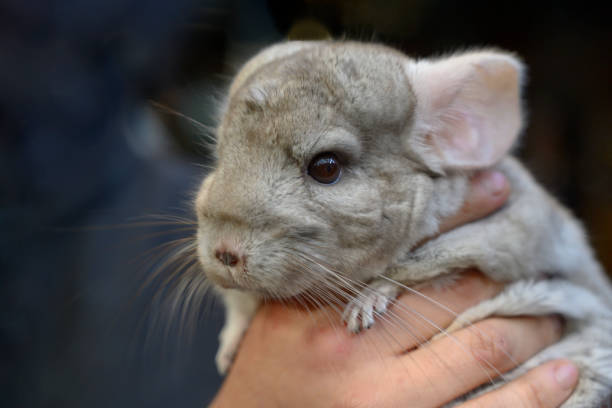
Maintaining Healthy Colouration
It’s important to note that while these colours are captivating, breeding for certain traits can sometimes result in health issues. Responsible breeders prioritize the overall well-being of the chinchilla, ensuring that their animals are healthy and robust.
If you are thinking about purchasing a chinchilla in a certain colour, do your homework on reliable breeders who put the health and welfare of their pets first. In this manner, you can both support moral breeding methods and appreciate the beauty of a chinchilla with a unique colour.
In the next section, we will explore the various coat types that chinchillas can possess and how genetics play a crucial role in determining their coats. Understanding these coat types will give you a deeper insight into your chinchilla’s appearance and how to care for them properly.
Identifying Chinchilla Coat Types
Chinchillas are not only diverse in colour but also in their coat types, each with its own distinctive characteristics. Understanding these coat types can not only help you appreciate the uniqueness of your chinchilla’s appearance but also provide insights into their genetic makeup.
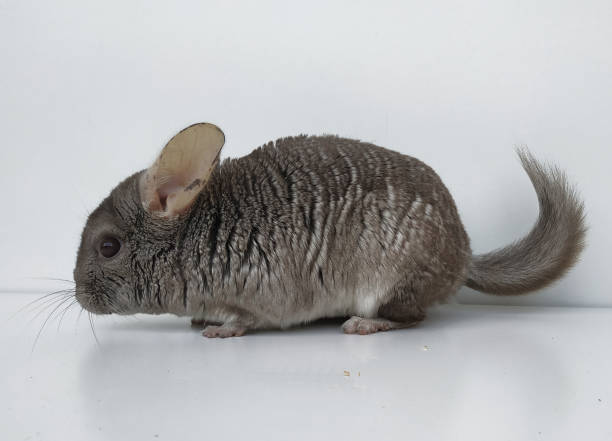
1. Standard Coat
When most people think of chinchillas, they think of the typical coat. Because of their fur’s extreme softness, plushness, and density, they are frequently bred for it. Standard coats are the most prevalent type among chinchilla pets; they are generally seen in colours like white, grey, and beige. It can be difficult to detect the skin underneath their thick fur.
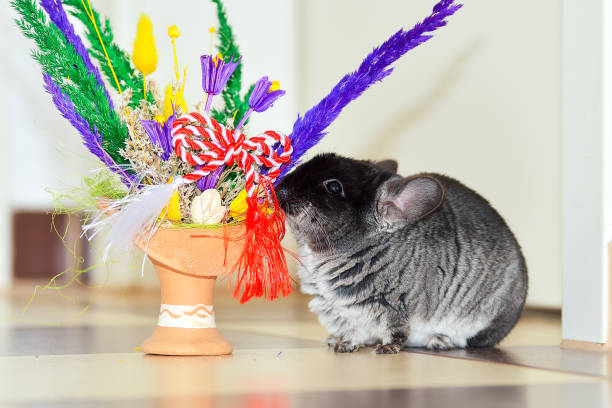
2. Velvet Coat
Velvet chinchillas have fur that’s exceptionally soft and plush, even more so than the standard coat. This is due to a genetic mutation that results in the hairs having a different texture. Velvet chinchillas are a treat to touch, and their fur feels like, well, velvet. While less common than the standard coat, they’re highly sought after by chinchilla enthusiasts.
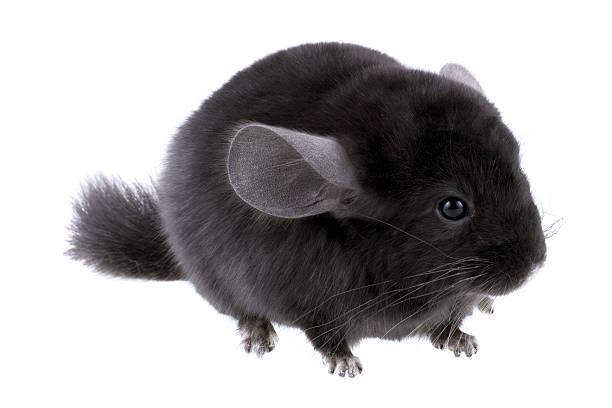
3. Ebony Coat
Ebony chinchillas have a darker, richer coloration compared to standard coats. Their fur is dense, and the hairs are shorter, giving them a sleek appearance. The name “ebony” is fitting as their coat can be deep black, dark grey, or even a striking sapphire blue. This coat type is particularly eye-catching and adds a touch of elegance to their appearance.
4. Other Coat Types
In addition to the primary coat types mentioned above, there are some rarer variations, such as the TOV (Touch of Velvet) coat, which combines the softness of velvet with the coloration of ebony, and the Royal Persian Angora (RPA) coat, characterized by extremely long and silky fur.
Each coat type has its own unique charm and requires specific care considerations. For example, velvet chinchillas need extra gentle handling due to their delicate fur, while ebony chinchillas may be more sensitive to temperature fluctuations because of their shorter fur.
Understanding your chinchilla’s coat type can enhance your bond with them and help you provide the best possible care. In the next section, we’ll delve into the genetics behind these coat types, shedding light on how they are inherited and why they vary from one chinchilla to another.

Personality Traits Linked to Coat Colors
While the colour of a chinchilla’s coat primarily determines its appearance, some intriguing theories suggest a potential link between coat colour and personality traits. While these connections are far from definitive, they offer an exciting perspective on the complexities of chinchilla genetics and behaviour.
1. Standard Grey Chinchillas: The Playful Extroverts
Standard grey chinchillas, being the most common variety, are often considered the extroverts of the chinchilla world. They are known for their playful and curious nature, often displaying a high level of social interaction. Owners of standard grey chinchillas often describe them as outgoing and energetic, making them a popular choice for those seeking an engaging companion.
2. Ebony Chinchillas: The Calm and Observant Types
Ebony chinchillas are thought to be more reserved and observant compared to their grey counterparts. Their darker coat colours might suggest a more serious demeanour, but this doesn’t mean they lack affection or playfulness. Ebony chinchillas often exhibit a quieter and more thoughtful disposition, making them suitable for individuals who appreciate a more calm and introspective pet.
3. Beige Chinchillas: The Sweet and Gentle Personalities
Beige chinchillas are often characterized as sweet-natured and gentle. Their coat colour, which is a creamy beige or tan, seems to correlate with a milder temperament. Beige chinchillas are frequently recommended for families with children or first-time chinchilla owners due to their docile and affectionate nature.
It’s important to remember that these personality traits associated with coat colours are generalized observations and can vary greatly from one chinchilla to another. Each chinchilla, regardless of its coat colour, has its unique personality, influenced by genetics, early life experiences, and socialization.
While considering a chinchilla’s potential personality traits based on its coat colour can be intriguing, it’s essential to spend time with the individual chinchilla before making any assumptions. Building a strong bond with your chinchilla and understanding their unique personality is key to a happy and fulfilling pet-owner relationship.
In the following section, we will delve deeper into the concept of rare chinchilla colours, exploring some of the most uncommon and sought-after coat variations.
The Rarity Factor: Uncommon Chinchilla Colours
While standard grey, beige, and ebony chinchillas are the most prevalent and readily available options, there exists a world of rare and exotic chinchilla colours that capture the imagination of enthusiasts. These unique coat variations, often harder to find, come with their own set of charms and considerations.
1. Mosaic Chinchillas: A Patchwork of Colours
Mosaic chinchillas are a true marvel of nature. Their coats are a stunning mosaic of various colours and patterns, reminiscent of a vibrant patchwork quilt. These chinchillas sport a tapestry of shades, including patches of white, grey, black, and even beige. Mosaic chinchillas are relatively rare, and their unique appearance makes them highly coveted among chinchilla aficionados.
2. Sapphire Chinchillas: A Hint of Blue Elegance
Sapphire chinchillas are known for their captivating blue-grey fur. This beautiful coloration gives them an almost regal appearance. However, sapphire chinchillas are relatively rare, and their striking colour comes with special care requirements. Due to their unique genetics, they can be more prone to certain health issues, making regular veterinary check-ups crucial.
3. Black Velvet Chinchillas: Dark and Exquisite
Black velvet chinchillas are characterized by their rich, dark fur, often appearing jet black. This coat colour exudes elegance and sophistication. Like sapphire chinchillas, black velvet chinchillas are less common and require attentive care to maintain their luxurious coat.
4. Violet Chinchillas: A Soft Lavender Hue
Violet chinchillas have a captivating lavender or lilac tint to their fur. This rare colour variation adds a touch of whimsy and charm to their appearance. Their coloration results from a unique genetic combination, and their coats require gentle handling to preserve their delicate hue.
While these rare chinchilla colours are undeniably beautiful, it’s essential to note that they may come with additional challenges. Rarer coat colours can sometimes be associated with genetic predispositions to certain health conditions, so it’s crucial to choose a reputable breeder who prioritizes the well-being of their animals.
If you’re considering adopting one of these unique chinchilla colours, be prepared to invest time and effort into their care. Proper grooming and regular veterinary check-ups are essential to ensure they remain healthy and vibrant.
In the next section, we’ll provide valuable tips on caring for chinchillas with different coat types, including those with rare and exotic colours. Understanding their specific needs is vital to keeping these special pets happy and thriving.

Tips for Caring for Different Coat Types
Caring for chinchillas with various coat types requires a tailored approach to meet their specific needs. Whether you have a standard grey chinchilla, a velvet chinchilla, an ebony chinchilla, or one with a rare colour like mosaic or sapphire, here are some essential care tips:
1. Grooming Matters
- Standard Grey Chinchillas: Their dense fur requires regular dust baths to maintain its cleanliness and health. Provide a dust bath container with chinchilla-specific bathing sand, and allow them to indulge in this natural behaviour.
- Velvet Chinchillas: Their exceptionally soft fur is delicate and should be handled gently. Avoid over-bathing to prevent fur damage. Dust baths are suitable but be extra cautious with their sensitive fur.
- Ebony Chinchillas: Shorter fur means they might be more sensitive to temperature fluctuations. Ensure a consistent and comfortable room temperature (ideally between 60-70°F or 15-24°C).
- Rare and Exotic Colours: Mosaic, sapphire, and other unique colours may have their specific grooming needs. Consult with an experienced chinchilla breeder or veterinarian to understand their specific care requirements.
2. Dietary Considerations
- Regardless of coat type or colour, all chinchillas need a balanced diet of high-quality chinchilla pellets, fresh hay, and access to clean water. Avoid feeding them fruits, vegetables, or sugary treats, as these can lead to health issues.
3. Veterinary Care
- Regular veterinary check-ups are essential for all chinchillas. However, owners of rarer colour variations like sapphire or violet should be particularly vigilant about health monitoring due to potential genetic predispositions.
4. Social Interaction
- Chinchillas, regardless of coat type or colour, are social animals and thrive on interaction. Spend quality time with your chinchilla through play, exercise, and gentle handling to build a strong bond.
5. Chinchilla-Proofing Their Environment
- Ensure a safe and chinchilla-proofed environment. Chinchillas are excellent chewers and can potentially damage electrical cords and other hazards. Provide a secure, spacious cage with plenty of toys and opportunities for exercise.
6. Psychological Stimulation
- Mental stimulation is crucial for chinchillas. Offer toys, tunnels, and safe chewing materials to keep them engaged and prevent boredom.
Remember that each chinchilla is an individual with its unique needs and preferences. Pay close attention to your pet’s behaviour and adjust their care accordingly. Whether your chinchilla sports a standard grey coat or boasts a rare and exotic colour, your love and attentive care are the keys to their happiness and well-being.
In the following section, we will guide you through the process of selecting the perfect chinchilla, considering both their coat type and personality, to ensure a harmonious and rewarding pet-owner relationship.
Selecting the Perfect Chinchilla for You
Choosing a chinchilla that fits your lifestyle and preferences involves considering both their coat type and personality. Here are some essential steps to help you find the perfect furry companion:
1. Research and Educate Yourself
- Start by researching the various chinchilla coat types and colours, as well as the potential personality traits associated with them. Understanding your options is the first step in making an informed choice.
2. Find a Reputable Breeder or Rescue Organization
- Whether you’re seeking a specific coat colour or type, it’s essential to source your chinchilla from a reputable breeder or rescue organization. Responsible breeders prioritize the health and welfare of their animals, while rescue organizations provide homes for chinchillas in need.
3. Spend Time Interacting with Chinchillas
- Visit the breeder or rescue organization in person if possible. Spend time observing and interacting with the chinchillas to get a sense of their personalities. Pay attention to their reactions to handling, socialization, and their general behaviour.
4. Consider Your Lifestyle and Preferences
- Reflect on your own lifestyle and preferences. Are you looking for an active and playful chinchilla, or do you prefer a more laid-back companion? Consider factors like your living space, daily routine, and how much time you can dedicate to chinchilla care.
5. Seek Guidance from Experts
- Don’t hesitate to ask the breeder or rescue organization for guidance. They can provide valuable insights into the temperament and care requirements of the chinchillas they have available.
6. Be Open to the Unexpected
- While you may have a specific coat colour or type in mind, be open to unexpected connections. Sometimes, a chinchilla’s personality may completely captivate you, leading you to choose a companion based on their unique qualities rather than their appearance alone.
7. Responsible Ownership
- Remember that owning a chinchilla is a long-term commitment. Ensure you have the time, resources, and dedication to provide proper care and a loving environment for your new furry friend.
By carefully considering both coat type and personality, you can increase the likelihood of finding the ideal chinchilla to complement your life. Keep in mind that while coat colours and types are fascinating, a chinchilla’s personality is what will truly make them a cherished member of your family.
In the concluding section of this guide, we will summarize the key takeaways about chinchilla colours and coats, emphasizing the importance of responsible pet ownership and celebrating the uniqueness of these wonderful creatures.
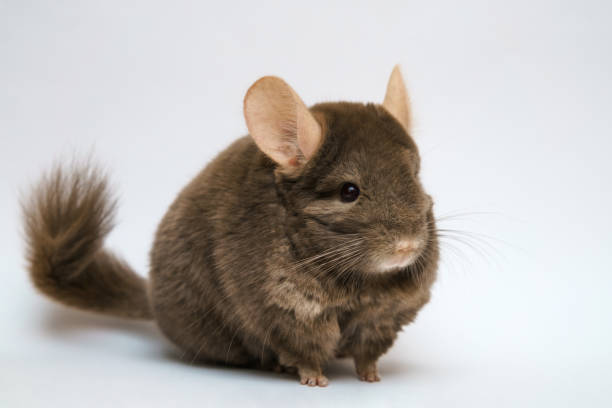
Final Thoughts
As you embark on your chinchilla journey, remember that while coat colours and types are undeniably fascinating, the most significant aspect of chinchilla ownership is the bond you build with these charming, unique creatures. They will not only bring joy and companionship into your life but also remind you of the beauty and diversity of the animal kingdom.
Thank you for joining us on this exploration of chinchilla colours and coats. May your chinchilla companion fill your life with endless love and delightful moments.









